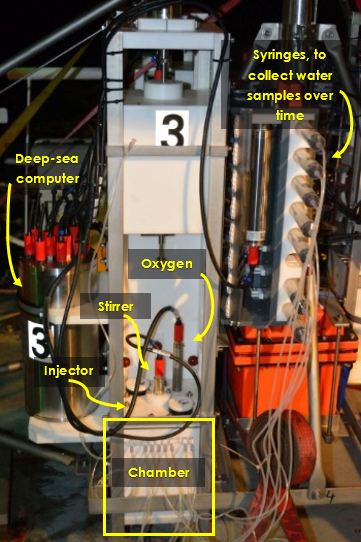
By Marta M. Cecchetto and Dr. Andrew K. Sweetman, The Lyell Centre for Earth and Marine Science, Heriot Watt University, Edinburgh
June 14, 2018
Most of the science taking place aboard the R/V Kilo Moana is focused around finding out what microbes and animals live in and just above the seafloor in Areas of Particular Environmental Interest (APEIs) 1, 4, and 7. This type of information is essential for figuring out if the APEIs are adequate preservation zones for deep-sea mining activities in the Clarion-Clipperton Fracture Zone (CCFZ). However, it is just as important to characterise how the seafloor is working, or as we like to call it, determine its ecosystem function.
Ecosystem functioning is vital to the provision of services that any ecosystem provides, and you and I rely on this very process to live. For example, the nutrients that fuel primary (algal production) and secondary (plankton production) production in the ocean that support huge fish populations, and which we exploit for food, are produced by tiny animals and microbes cycling organic matter in the water column and seafloor. This organic-matter cycling is a type of ecosystem function.
Over the past month, the Heriot-Watt University team have been deploying two unique seafloor lander systems to quantify organic matter cycling and measure ecosystem functioning. The first lander, named Yellow Tang after the Pacific coral-reef fish, is a micro-profiling lander that literally pokes holes in the seafloor with fine (0.1 millimeter thick at the tip) glass chemical sensors. The reason for poking holes in the seafloor is to measure how oxygen concentrations change through the sediment. The neat thing about the micro profiler is that the fine oxygen sensors (called microsensors) measure oxygen three times a second and every 0.025 millimeter through the sediment to 15 centimeter sediment depth, thereby giving us high-resolution profiles of oxygen conditions throughout the sediment. From the change in oxygen concentration, we can calculate the amount of oxygen that is being consumed by chemical reactions and aerobic (oxygen breathing) microbes living in the sediment and thus the amount of organic matter being processed.
In addition to mistreating the deep sea by sticking fine needles into its sediments, our group has also been busy measuring which organisms are most important in cycling organic material. These experiments have been carried out using our second lander, Malihini, which literally means “new comer” in Hawaiian. Malihini is a benthic chamber lander and the latest lander to join the five-strong lander fleet at the Lyell Centre for Earth and Marine Science and Technology at Heriot-Watt University.

Malihini chamber. Image courtesy of the DeepCCZ expedition. Download (jpg, 206 KB).
Malihini consists of three benthic chambers of 484 cubic centimters connected to three deep-sea computers. Once the lander reaches the seafloor at 5,000 meters depth (it takes 3 hours!), the chambers are driven into the sediment by onboard motors controlled by the computers. Approximately 1.5 hours after this, algae that has previously been labelled with a heavy stable isotope (isotopes are forms of the same element that differ in the number of neutrons in the nucleus) are injected into the chamber and sink to the sediment surface. This algae is then consumed by seafloor bacteria and tiny animals.
While the organisms are busy chomping down on their deep-sea feast, oxygen sensors mounted in the chamber lids measure changes in oxygen concentration every minute for 36 hours, allowing us to measure sediment respiration. Every six hours, a syringe sampler is turned on by the computers and a water sample is extracted from the benthic chamber to allow us to measure the amount of nutrients and carbon dioxide being produced by the seafloor biological community. After 36 hours, the chambers are sealed by a closable door and the chambers are extracted from the sediment by the lander motors. We then recall the lander to the surface by sending an acoustic signal which tells the lander to drop its weights. After dropping its weights, the lander is positively buoyant and floats slowly up to the surface where we recover it and sample its deep-sea spoils.
When we return to Scotland, we will measure the amount of heavy isotopes in the microbes and animals, which will allow us to estimate how much organic matter was processed by the seafloor community and which organisms were most important in this process. We will then compare our results to other data from previous experiments to build a picture of how ecosystem functioning at the deep seafloor changes across the CCFZ and how similar ecosystem functioning is within and between the APEIs.